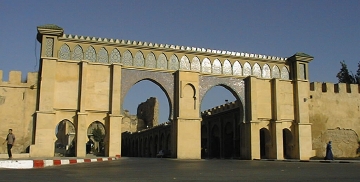
Meknes
August 30th - August 31st, 1999

The most modern of the ancient capitols of Morocco, we skipped over Meknes in our first pass through Morocco in favor of Fes and Marrakesh. While Meknes is an old city, its heyday was in the 17th century when the brutal Sultan Moulay Idriss turned it into his capitol. It's told that he regularly supervised the work on his palace and the city walls himself. He would tour the works with a pickax and whip, and workers whose efforts mildly displeased he would flog, while those whose skills were sorely lacking would be pickaxed and their bodies thrown into the setting walls (management techniques Jim can appreciate). As much of the work on Meknes is newer than Fes or Marrakesh, the city is well preserved and fun to tour.
As many tourists give Meknes a miss, it turns out to be a city free of many of the touts and hassles of some of the tourist hells we've seen in Morocco. Also, the restaurants are surprisingly good and affordable. No one tried to cheat us while we were in Meknes, and waiters and taxi drivers tried to hand back tips we gave them. It renewed our sorely tested faith in Moroccans.
Also, the forty days mourning over King Hassan II's death ended on our last day in Meknes (the 31st). While strict muslims even in Morocco don't drink, most Moroccans turn out not to be so strict. They were hoopin' and hollerin' that Tuesday evening until all hours, and Wednesday morning was nice and quiet as everyone nursed their hangovers.
Tomb of Moulay Idriss
Sultan Moulay Idriss' final resting place lies within his Imperial palace, and the associated mosque is only the second one we were allowed to enter in Morocco. Beautifully detailed and quite relaxed, we enjoyed lingering away from the hot sun. Idriss' tomb is in the top photo here, surrounded by an intricate wooden and marble border and flanked by two grandfather clocks. The clocks were a present from French king Louis XIV after his daughter rejected Idriss' proposal of marriage. The bottom two photos show the grand ceiling and rising arches of the tombs foyer, and the fountain underneath them.
| |
|
|
Bab El Mansour
As all old Moroccan cities have high and impregnable walls, the gates (or babs) have special significance. Idriss set out to build the grandest yet seen. Built with marble columns and detailing stolen from the ancient Roman city of Volubilis, the outside of Bab El Mansour is quite a sight. The opposite side is a completely different matter; we walked on by it, thinking it was just a utility entrance. Those entering the bab were made to negotiate a dogleg entrance, especially designed to slow attacking armies if the bab ever were breached.
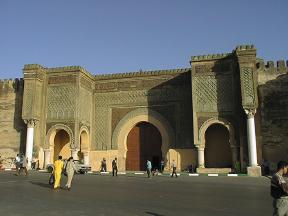
Koubbat as-Sufara
As in the rest of Morocco, many old structures have been designated as UNESCO World Heritage sites. Koubbat as-Sufara, the reception building for ambassadors in Idriss' Imperial city, proudly displays its heritage status in a large marble memorial (below left). Part of the structure houses an underground granary for storing food necessary to withstand a long siege (below right).
|
|
Volubilis
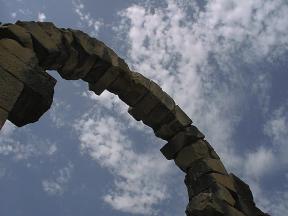
Some thirty kilometers out of Meknes lies the earliest city in these parts of Morocco, the ancient Roman city of Volubilis. Built in the 2nd and 3rd century AD, it was the capitol of the Roman district of Mauritania. Rome cultivated this part of North Africa as a major agricultural center, deforesting the entire valley and turning it into farmland. When Rome withdrew from North Africa, Berbers moved in and made it their own until Moulay Idriss forcibly moved the population of Volubilis to Meknes and mined the ancient structures for columns and marble for his Imperial city. The Lisbon earthquake of 1755 finished off what structures remained standing, and so it was until partially reconstructed and reopened in 1994. Designated as (you guessed it) a UNESCO World Heritage site, the ruins are a a joy to tromp around in.
Most reconstruction has occurred along the main road of Volubilis, Decamanus Maximus. Fractured columns and partial arches recall the grandeur of this ancient capitol. The bottom left photo below is Triumphal Arch, once adorned with a giant bronze chariot and nymph fountains. Bottom right is the ruins of the Basilica, the ancient Roman courthouse of Volubilis.
|
|
|
|
Peppered through out Volubilis are Roman mosaics, many of which have held up unbelievably well given that they're 1800 years old and have been exposed to the elements for the last 300 years. The top left mosaic came from the temple of Venus, while the others we're really not sure of. The craftsmanship of the mosaics truly is fantastic; throughout the years and all the abuse almost all of the mosaics are totally flat with no loose stones.
|
|
|
|
Inbetween Meknes and Volubilis lies the city of Moulay Idriss. Founded as a destination for pilgrims by the first Moulay Idriss, a third generation descendant of Mohammed, the city is built on top of a steep hill. As all monuments and religious buildings are off limits to us (infidels can't even stay overnight there), we gave the city a miss. We imagine that the winding streets and view offered by Moulay Idriss are quite a sight, though.
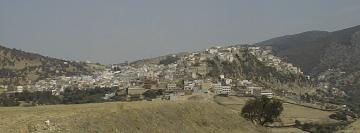
Madersa Bou Inania
Nestled next to the grand mosque in Meknes' medina lies the 14th century college of theology and muslim law, Madersa Bou Inania. Smaller than the Koranic schools (medersa) we've seen, the madersa is quite nicely preserved. From the roof of the madersa one can survey the roofs of the medina, including the towers of the grand mosque and a neighbor in the distance.
|
|
Our Find in Meknes
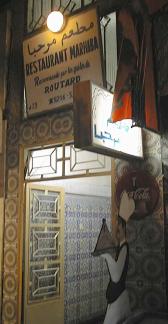 We mentioned that the food in Meknes is good and cheap. Our pick in
both of those categories has to be Restaurant Marhaba. A filling dinner
of Moroccan soup, bread and sweet potato fritter comes in at 6 dirhams (60
cents). The restaurant is clean and nice looking too, unlike so many of
the cheap Moroccan pits we've seen.
We mentioned that the food in Meknes is good and cheap. Our pick in
both of those categories has to be Restaurant Marhaba. A filling dinner
of Moroccan soup, bread and sweet potato fritter comes in at 6 dirhams (60
cents). The restaurant is clean and nice looking too, unlike so many of
the cheap Moroccan pits we've seen.